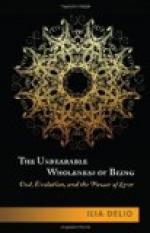The Latin poets, whose study would probably have counteracted the universal barbarism, were regarded as dangerous, the gods of antiquity being identified with the demons of the Scriptures. This view was responsible for the loss of many a valuable manuscript. The favourite haunts of the demons were the convents, originally designed as battlefields on which the struggles with the demons were to be fought out, but frequently perishing in superstition and ignorance. Every monk had visions of devils; miracles occurred continually; the torturing problem was as to whether they were worked by God or the devil. Nature was merely a collection of mystic symbols, divine—or perhaps diabolical—allegories, whose meaning could be discovered by a correct interpretation of the Bible. Everything which could possibly happen was recorded in the Scriptures; they contained the true explanation of all things. It was only a matter of selecting the right word and interpreting it correctly, for every word was ambiguous and allegorical. Every natural occurrence—an eclipse of the sun, a comet, or even a fire—stood for something else; it was the symbol of a spiritual event concealed behind a phenomenon. The allegorical interpretation of the Bible was carried to the point of abstruseness because every word was considered of necessity to have an unfathomably profound meaning. The following amazing interpretation is by the highly-gifted German poet and mystic, Suso: “Among the great number of Solomon’s wives was a black woman whom the king loved above all others. Now what does the Holy Ghost mean by this? The charming black woman in whom God delights more than in any other, is a man patiently bearing the trials which God sends him.” Abelard’s interpretation of the black woman is even worse; he maintained that though she was black outside, her bones, that is her character, were white. A really remarkable deed of bad taste was committed by the monk, Matfre Ermengau, the author of the Breviari d’Amor, at a time when civilisation had already made considerable strides. He sent his sister a Christmas present, consisting of a honey-cake, mead, and a roast capon, accompanied by the following letter: “The mead is the blood of Christ, the honey-cake and the




